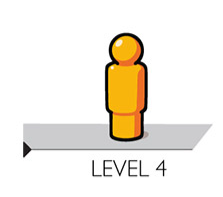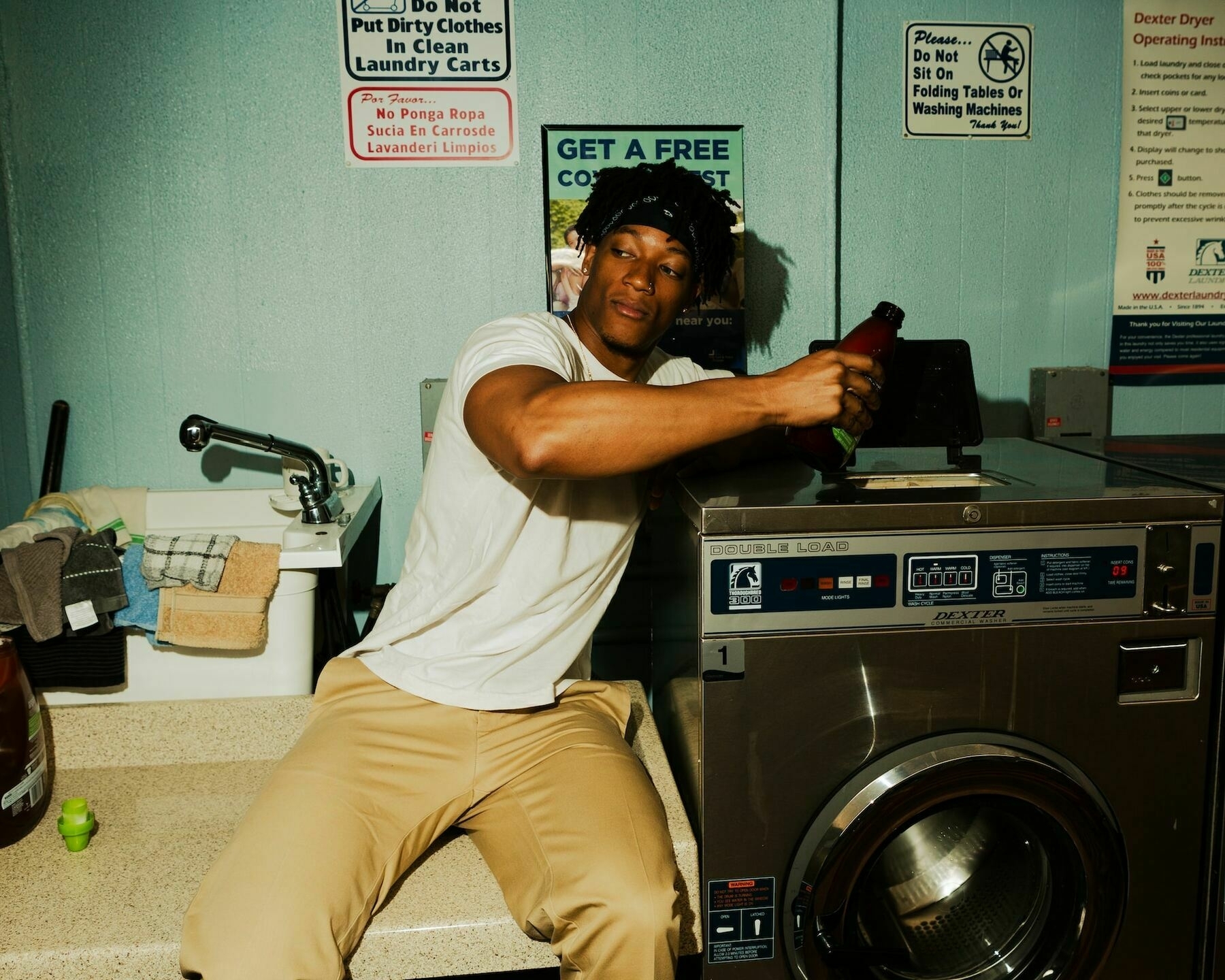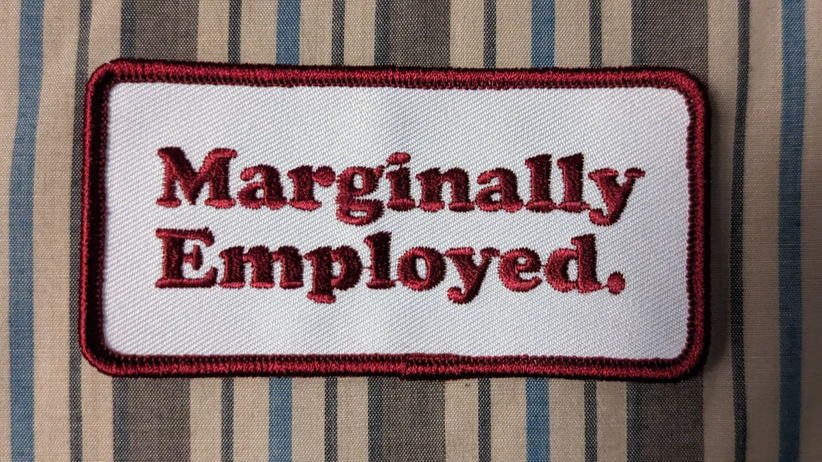Jobs, AI, and human worth
I’m sharing this article to make a comment about the framing for these kinds of things. The article is an extract from a book by David Runciman, and implicitly links human worth to jobs.
Part of the existential dread of AI replacing humans is that, if your job is your life, then who are you without the doing? Instead of hand-wringing about robots and machines, perhaps our time is better spent figuring out who we are and how we want to flourish.
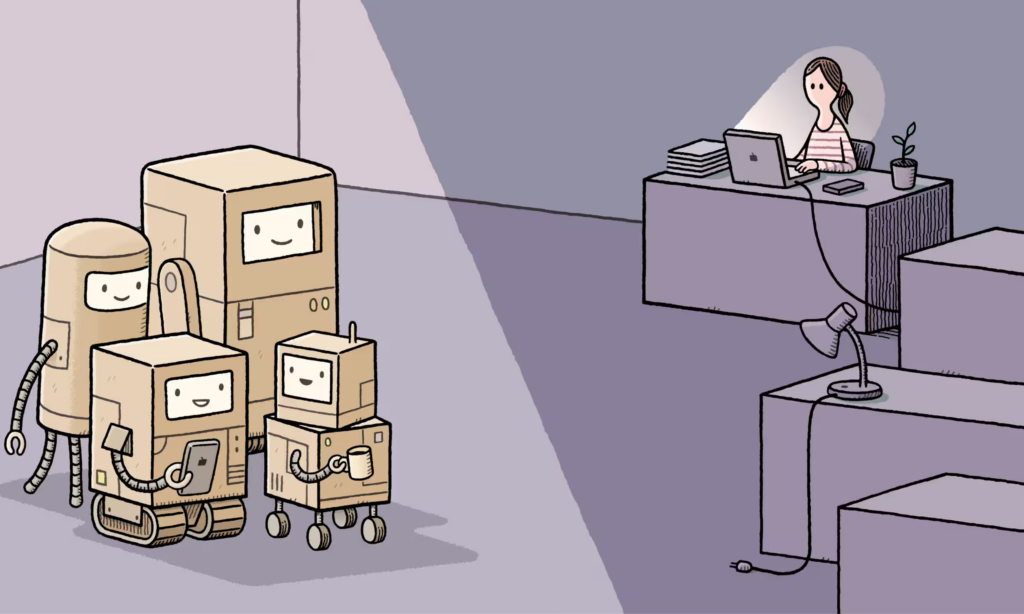
In the slew of reports published in the 2010s looking to identify which jobs were most at risk of being automated out of existence, sports officials usually ranked very high up the list (the best known of these studies, by Carl Benedikt Frey and Michael Osborne in 2017, put a 98% probability on sports officiating being phased out by computers within 20 years). Here, after all, is a human enterprise where the single most important qualification is an ability to get the answer right. In or out? Ball or strike? Fair or foul? These are decisions that need to be underpinned by accurate intelligence. The technology does not even have to be state-of-the-art to produce far better answers than humans can. Hawk-Eye systems have been outperforming human eyesight for nearly 20 years. They were first officially adopted for tennis line calls in 2006, to check cricket umpire decisions in 2009 and, more recently, to rule on football offsides.Source: The end of work: which jobs will survive the AI revolution? | The Guardian[…]
Efficiency – even accuracy – turns out not to be the main requirement of the organisations that employ people to give decisions during sports games. They are also highly sensitive to appearance, which includes a wish to keep their sport looking and feeling like it’s still a human-centred enterprise. Smart technology can do many things, but in the absence of convincingly humanoid robots, it can’t really do that. So actual people are required to stand between the machines and those on the receiving end of their judgments. The result is more work all round.
[…]
How things look isn’t everything. There are significant parts of every organisation where appearance doesn’t matter so much, in the backrooms and maybe even the boardrooms that the public never gets to see. Behind-the-scenes technical knowledge that underpins the performance of public-facing tasks is likely to be an increasingly precarious basis for reliable employment. This is true of many professions, including accountancy, consultancy and the law. There will still be lots of work for the people who deal with people. But the business of gathering data, processing information and searching for precedents can now more reliably be done by machines. The people who used to undertake this work, especially those in entry-level jobs such as clerks, administrative assistants and paralegals, might not be OK.
[…]
History offers a partial guide to what might happen. Worries about automation displacing human workers are as old as the idea of the job itself. The Industrial Revolution disrupted many kinds of labour – especially on the land – and undid entire ways of life. The transition was grim for those who had to switch from one mode of subsistence existence to another. Yet the end result was many more jobs, not fewer. Factories brought in machines to do faster and more reliably what humans used to do or could never do at all; at the same time, factories were where the new jobs appeared, involving the performance of tasks that were never required before the coming of the machines. This pattern has repeated itself time and again: new technology displaces familiar forms of work, causing massively painful disruption. It is little consolation to the people who lose their jobs to be told that soon enough there will be entirely new ways of earning a living. But there will.
Did people in the past look older for their age?
I’m 42 but look much younger than my father did at his age. And I’m sure that he looked younger than my grandfather did at his age. This is an interesting article about why.
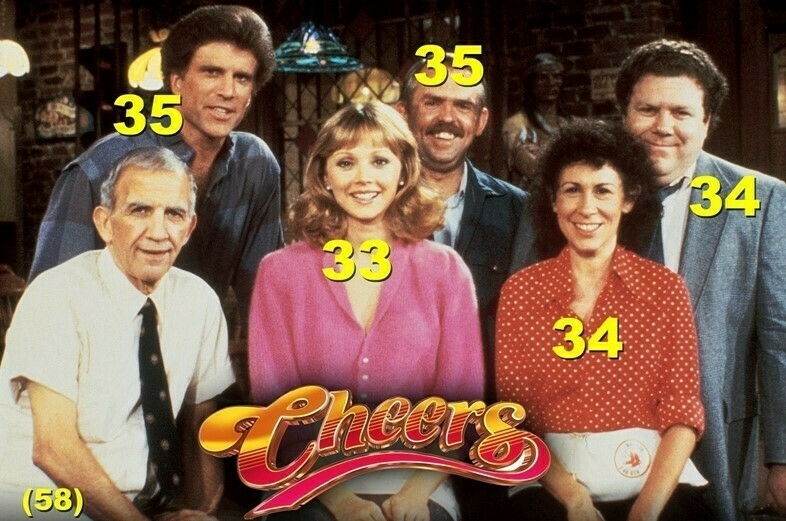
There’s a meme that makes the rounds every so often. It’s a group shot of the cast of 80s sitcom Cheers, with the ages of each actor displayed on the image. Every time it comes back around, people express surprise and disbelief that this group of what looks to be middle-aged folk are actually in their twenties and thirties. With his greying moustache and receding hairline, John Ratzenberger looks far older than what we might now imagine a 30-something man to look like – current 35-year-old actors Michael Cera and Nicholas Braun, for example, look significantly younger in comparison.Source: Why did people in the past look so much older? | Dazed[…]
While factors like diet, skincare and aesthetic procedures can make us physically look younger – hairstyles, make-up and fashion also play a role in how youthful we appear. While someone with 2023-esque micro bangs may scream young to us, we associate photos of 80s hairstyles and big shoulder pads with being older, even if the person in the image is the same age as us. This is partly because of how we consider trendy hairstyles and fashion of that time to be outdated.
[…]
Today we might be obsessed with preserving our youth, but this wasn’t always the case. In past decades, popular trends often existed to make young people appear more sophisticated and bold. “The dramatic nature of [80s] hairstyles often conveyed a sense of confidence and authority, which could be associated with older individuals,” hairdresser Gwenda Harmon says. “Certain hairstyles of the 1980s actually made some youth appear older due to their bold and sophisticated nature.”
Ask culture vs guess culture
I’ve seen this culture clash outlined before, although I wouldn’t necessarily use the labels ‘ask’ and ‘guess for the different approaches. I was raised by a mother who very much (still!) relies on inference to live her life. I’ve found being much more direct useful in living my own.
(I’d also note that the author seems to be playing fast-and-loose with the term ‘Western’ to mean ‘American’ here as British people are much more likely to be guessers than askers in my experience.)
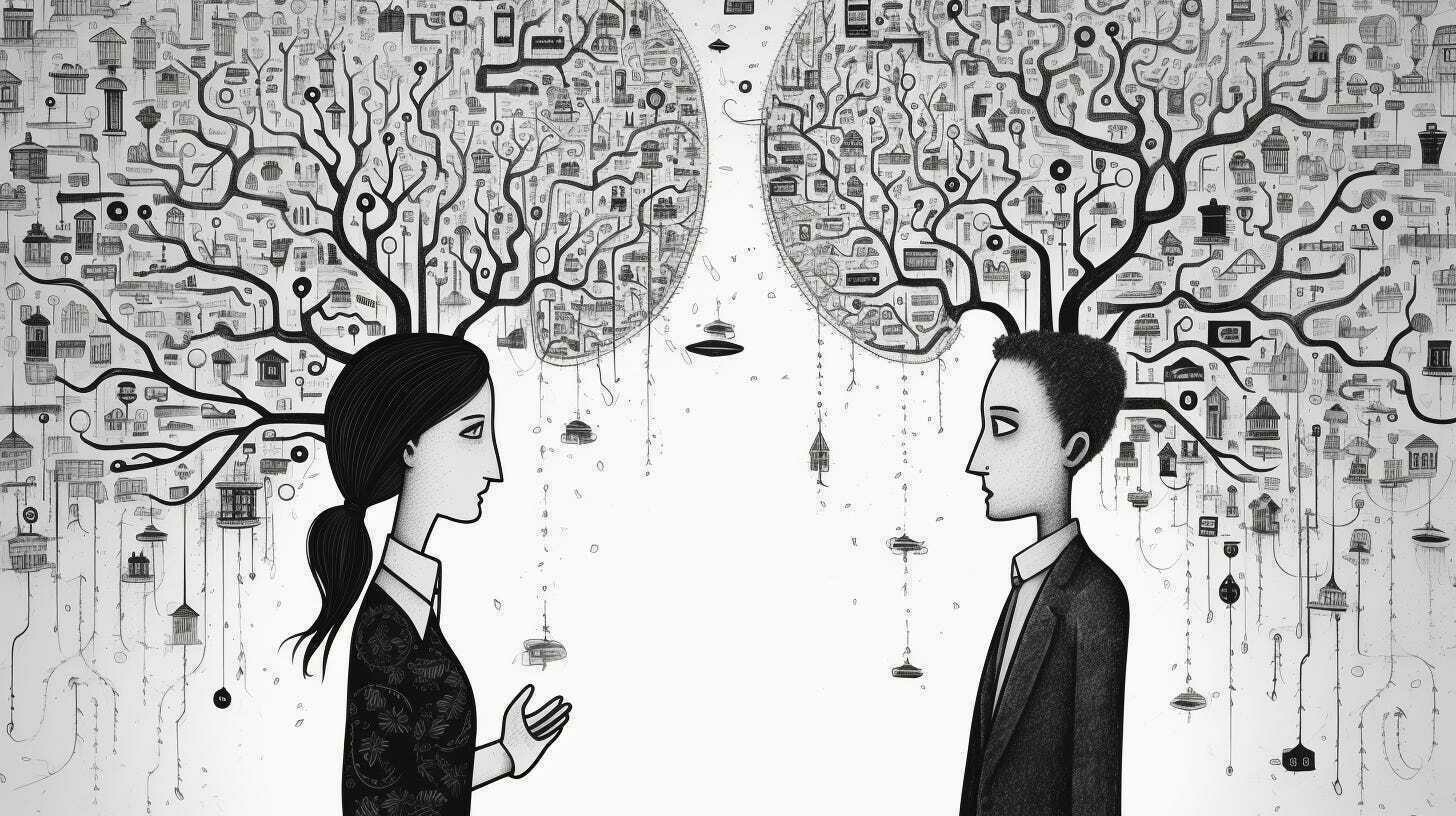
Ask culture and guess culture are vastly different in behavior and expectations. Here are some highlights:Source: Ask vs guess culture | Tech and TeaAsk culture expectations
Guess culture expectations
- Ask for what you want, even if it seems out of reach or like a big unreasonable request
- Take care of your own needs, and others will take care of theirs
- It’s fine to make requests that people will probably say no to
- People say yes to requests that you truly feel good about, say no to ones they don’t
[...]
- Only ask for something if you’re already pretty sure the other person will say yes
- Read an abundance of indirect contextual cues to determine if your request is reasonable to make
- It’s rude to put someone in a position where they have to say no to you
- If the appropriate feelers and context are set, you will never have to make your request at all.
If you’re more a guess-culture person, asking people for help without knowing their circumstances can feel rude or intrusive. Broadcasting publicly your need for help can feel awkward and vulnerable.
[…]
Western society is very much ask culture. A classic example can be found in proverbs. “A squeaky wheel gets the grease” is an American proverb, enforcing the ideas of individualism and that asking for what you want will benefit you.
Life in 2050
Futurist Stowe Boyd imagines life in 2050, through three scenarios. I can’t help but think that ‘Collapseland’ (excerpted below) is the most likely outcome. Sadly.
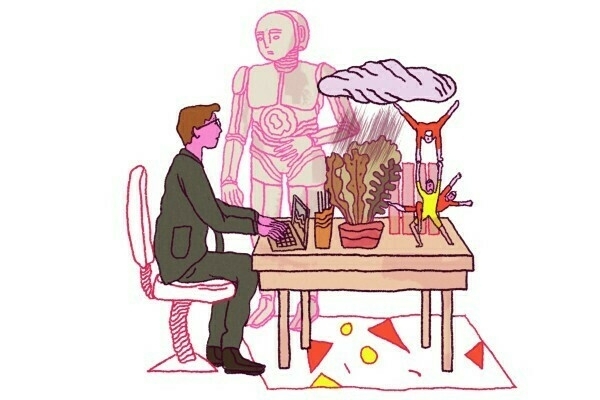
Collapseland is where everything goes pear shaped. Dithering by governments and corporations has allowed climate change to push the world into increased heat, drought, and violent weather. The Human Spring of the 2020s led to a conservative backlash and a suppression of the movement itself. It also led to a suppression of advancements in AI, since it became associated with the science orientation of the movement.Source: What Will a Corporation Look Like in 2050? | WIREDBut governments and corporations get their act together in the late 2020s and 2030s to avert an extinction event via the global adoption of solar. However, this only comes after a serious ecological catastrophe has occurred. Inequality remains unchecked, and the poor become much poorer.
Collapseland businesses are much like businesses of 2015. Most efforts are directed toward basic requirements — like desalinating water, relocating people away from low-lying or drought stricken areas, and struggling with food production challenges. As a result, little innovation has taken place. It’s no different from the company you work for today, except longer hours, fewer co-workers, less pay, and much more dust. To increase profits, corporations have cut staff and forced existing workers to work harder.
Context is everything, especially with books
When I was younger I slogged through some terrible books that, because they were deemed ‘classics’, I thought I should read. Thankfully, I’m a lot more ruthless with non-fiction and, in fact, these days I’m happy to give up on a book I’m not finding enjoyable/relevant after 50 pages.
The interesting thing, though, is that it’s always worth coming back to books. Sometimes, a change in interest, age, or context can completely change your relationship with them.

I used to believe that every book has an objective value. And I used to believe that this value is fixed and universal.Source: Is this a good book for me, now? | Mary Rose CookNow, I believe it’s much more useful to say something in this form: this book has this value to this person in this context.
[…]
The idea that a book’s value is best judged alongside the notional reader and their current context has some corollaries:
First, reading the books that your heroes cite as important will not necessarily be rewarding. If you admire Bret Victor for his work on computing interfaces, only some of his library will be high value to you because his library also includes lots of books that have nothing to do with UI.
Second, yes, it’s likely that “great books” may be high value in some more universal sense that is independent of reader and context. And, yes, this high value may come from something inherent in the quality of the books, rather than from the fact that they are about themes that are more relevant to more people. Yes, I probably wouldn’t dispute this. But I suspect that relevance to person and context is a better guide to what to read.
Third, book recommendation systems based on your reading history can be helpful, but only so much. You, now, are not represented by your reading history. You’ve changed. Making recommendations based on books you read twenty years ago might produce good books for you, now. But probably not.
Image: Thought Catalog
Using AI to aid with banning books is another level of dystopia
I’m very much optimistic about the uses of AI tools such as LLMs to help with specific tasks. See the latest post on my personal blog, for example.
However, what I’m concerned about is AI decision-making. In this case, a crazy law is being implemented by people who haven’t read the books in questions who outsource the decision to a language model that doesn’t really understand what’s being asked of it.
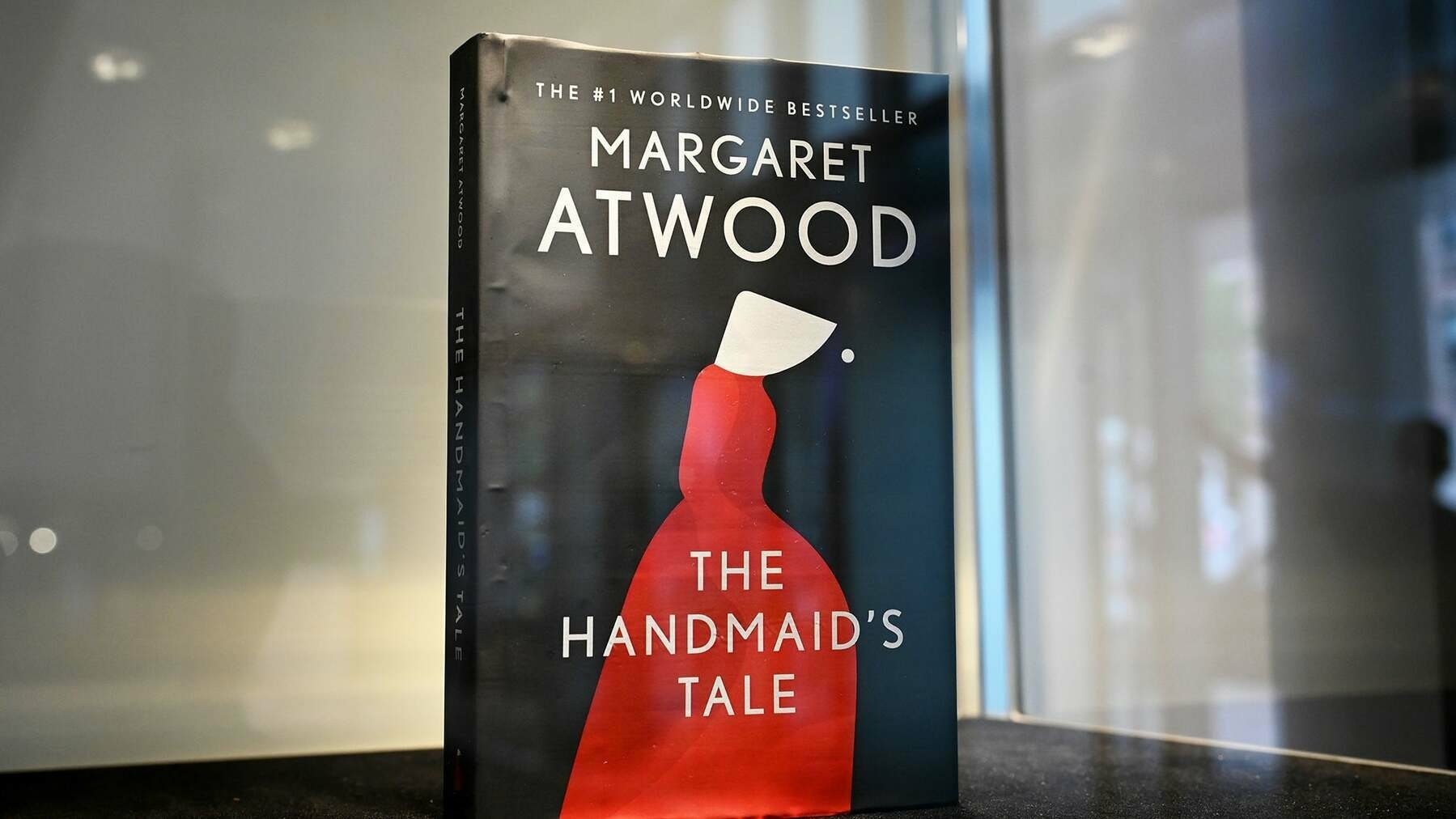
According to an August 11 article in the Iowa state newspaper The Gazette, spotted by PEN America, the Mason City Community School District recently removed 19 books from its collection ahead of its quickly approaching 2023-24 academic year. The ban attempts to comply with a new law requiring Iowa school library catalogs to be both “age appropriate” and devoid of “descriptions or visual depictions of a sex act.” Speaking with The Gazette last week, Mason City’s Assistant Superintendent of Curriculum and Instruction Bridgette Exman argued it was “simply not feasible to read every book and filter for these new requirements.”Source: School district uses ChatGPT to help remove library books | Popular Science“Frankly, we have more important things to do than spend a lot of time trying to figure out how to protect kids from books,” Exman tells PopSci via email. “At the same time, we do have a legal and ethical obligation to comply with the law. Our goal here really is a defensible process.”
According to The Gazette, the resulting strategy involved compiling a master list of commonly challenged books, then utilizing a previously unnamed “AI software” to supposedly provide textual analysis for each title. Flagged books were then removed from Mason City’s 7-12th grade school library collections and “stored in the Administrative Center” as educators “await further guidance or clarity.” Titles included Alice Walker’s The Color Purple, Margaret Atwood’s The Handmaid’s Tale, Toni Morrison’s Beloved, and Buzz Bissinger’s Friday Night Lights.
Income Level 4
I’ve had reason to reflect on how easy my life is recently. Not only am I a straight, middle-aged, able-bodied white guy but, according to Gapminder, I’m living life in a prosperous country on ‘Level 4’.
Worth pondering.
People at Income Level 4 earn more than $32 a day. At this Income Level, we find thee richest billion on the planet, who work in jobs that typically require at least 12 years of education — something those on the lower Income Levels cannot currently aspire to.Source: Income Level 4 | GapminderPeople at this Income Level are able to buy consumer goods, fly abroad with their families on holiday, and eat out at restaurants. None of these luxuries are available to people living at Levels 1 – 3, but are considered normal by most at Level 4.
The food they eat is often highly nutritious and diverse, as well as being rich in protein and vitamins. People at Level 4 can even buy pre-prepared food to save them time on cooking.
At this Income Level, not only electricity but also Internet connections are extremely reliable. Nearly every home has at least one TV and computer, and kitchens are equipped with stoves, ovens, toasters, and microwaves. Homes also have baths and showers installed with both hot and cold water — another luxury that is extremely rare at any other Income Level.
Instead of bikes and mopeds, people living at Level 4 usually own a car — sometimes even two per family. Public transport is also organized and readily available to everybody.
Perhaps most importantly, life at Level 4 is more secure than it is for people at levels 1 – 3. Not only are doors and windows locked securely, valuable property is usually insured against damage or theft. People also have bank accounts, access to credit, and pension funds for when they retire. Healthcare is also readily available to people living at Level 4, with basic medication available at affordable rates from local shops, and advanced and emergency medical treatment available locally to almost everybody.
AI sports recruitment
A few weeks ago, I watched part of the EA Sports FC 24 announcement video with my son. The CEO of Electronic Arts mentioned something that anyone who’s been paying attention already knows: games like FIFA (of which EA Sports FC is the spiritual successor) has transformed football.
There’s a symbiotic link between how people play football and how people play football video games. What’s less easy to spot is how talent is identified, nurtured, and shaped. That’s where articles like this one about AI in the behind-the-scenes processes comes in.
As someone with two very sporty kids, and one of whom is potentially on a pathway to professional football, this is fascinating to me.
There's no doubt that professional sports have been primed for the potential impact of artificial intelligence. Innovations have the potential to transform the way we consume and analyze games from both an administrative and fan standpoint. For soccer specifically, there are opportunities for live game analytics, match outcome modeling, ball tracking, player recruitment, and even injury predicting — the opportunities are seemingly endless.Source: Will AI revolutionize professional soccer recruitment? | Engadget[…]
Luis Cortell, senior recruiting coach for men’s soccer for NCSA College Recruiting, is a little less bullish, but still believes AI can be an asset. “Right now, soccer involves more of a feel for the player, and an understanding of the game, and there aren’t any success metrics for college performance," he said. “While AI won’t fully fill that gap, there is an opportunity to help provide additional context.”
At the same time, people in the industry should be wary of idealizing AI as a godsend. “People expect AI to be amazing, to not make errors or if it makes errors, it makes errors rarely,” Shapiro said. The fact is, predictive models will always make mistakes but both researchers and investors alike want to make sure that AI innovations in the space can make “fewer errors and less expensive errors” than the ones made by human beings.
[…]
The MLS said in a statement that ai.io’s technology “eliminates barriers like cost, geography and time commitment that traditionally limit the accessibility of talent discovery programs.” Felton-Thomas said it is more important to understand that ai.io will “democratize” the recruiting process for the MLS, ensuring physical skills are the most important metric when leagues and clubs are deciding where to invest their money. “What we’re looking to do is give the clubs a higher confidence level when they’re making these decisions on who to sign and who to watch.” By implementing the AI-powered app, recruitment timelines are also expected to be cut.
Secret family recipes (on the side of containers)
I love this 😂
In response to our call, 174 readers wrote in with stories of plagiarized family recipes. Hailing from New York to Nicaragua, from Auckland, New Zealand, to Baghpat, India, they prove that this is a global phenomenon. The majority of readers described devastating discoveries: They found supposedly secret recipes in the pages of famous cookbooks, and heard confessions from parents whose legendary dessert recipes came from the side of Karo Syrup bottles.Source: The Dirty Secret of ‘Secret Family Recipes’ | Gastro Obscura[…]
Several readers joked about family members threatening to take a secret recipe to the grave. To our surprise, we also received a story of a late-in-life confession:
My uncle was known around town as the “fudge man.” Every year, he would make pounds of it for Christmas parties, bake sales, and gifts. It was legendary—people would beg him for the recipe. When he was ill in the hospital, before he passed, his wife begged him for the recipe so she could keep his memory going. He replied, “It’s on the side of the marshmallow fluff container.”
–Jess Heller, Minnesota
Quake II remaster brings online LAN gaming
I can’t wait to play this. While I enjoy playing Doom Eternal by myself occasionally, LAN gaming the Quake II takes me back to being a teenager!
[embed]www.youtube.com/watch
In a surprise announcement at QuakeCon, publisher Bethesda Softworks announced the immediate availability of a light remaster of the classic first-person shooter Quake II, similar to the one for the first Quake that was released not that long ago.Source: Quake II gets a remaster for PC and consoles—and it’s exactly what it needs to be | Ars Technica[…]
You get a lot of content for 10 bucks; the package includes the game’s original campaign, both previously released expansions, Quake II 64, and a new campaign called Call of the Machine with 28 levels developed by Machine Games (the team behind the recent Wolfenstein games).
There’s also split-screen local multiplayer (up to four players), as well as LAN and online multiplayer.
Introducing Homo naledi
Science is awesome. I love the way that we continue to rediscover and reinterpret what it means to be human based on archaeology and scientific theories.

Using an unparalleled range of tests, experts are investigating whether a group of ‘ape-men’ succeeded in creating a complex human-like culture - potentially thousands of years before our own species, Homo sapiens, managed to do so.Source: Scientific discovery casts doubt on our understanding of human evolution | The IndependentAdding to the mystery is the fact that the now long-extinct species behaved in several key ways like modern humans - and yet appears to have been able to do that with brains which were only a third the size of ours.
The evidence assembled so far is beginning to suggest that these small-brained ‘ape-men’ may have been able to do seven remarkable things:
[...]
- Envisage an afterlife (in other words, a belief that some form of existence continues beyond death).
- Believe that an afterlife occurs in some sort of ‘underworld’, located beneath (rather than on or above) the world of the living. That implies that they may have developed some very embryonic sense of cosmology.
- Conceive the idea of physically burying their dead - in that ‘underworld’.
- Give grave goods to dead members of their community - an apparent act that implies that they may have believed that the dead would somehow be able to use them in an afterlife.
- Carry out potential rituals - specifically funerary meals - inside their ‘underworld’.
- Create rudimentary art (abstract designs) around the entrance to at least one of the burial chambers in that ‘underworld’.
- Plan some sort of relatively complex lighting system (either a succession of small fires and/or torches) to enable them to penetrate their ‘underworld’ and take their dead there.
“We know that what we’re discovering breaks totally new ground - and is therefore likely to be controversial. That’s why we are deploying every possible type of investigative technology to ensure that the maximum amount of additional evidence can be found,” said the leader of the Rising Star Cave investigation, National Geographic and University of Witwatersrand palaeoanthropologist, Professor Lee Berger, who with co-investigator, human evolution expert Professor John Hawks, has just published a detailed National Geographic book on the discoveries, entitled Cave of Bones.
Landmark ruling in climate trial
I’ve only been there once, but Montana is an absolutely beautiful place. And much like other places that people call home, those that live there want to keep it that way.
It’s really heartening to see youth-led action be successful in a court of law. I hope that this leads to more cases being brought around the world.

A Montana state court today sided with young people who sued the state for promoting the fossil fuel industry through its energy policy, which they alleged prohibits Montana from weighing greenhouse gas emissions in approving the development of new factories and power plants. This prohibition, 16 plaintiffs ages 5 to 22 successfully argued, violates their constitutional right to a "clean and healthful environment in Montana for present and future generations."Source: Montana loses fight against youth climate activists in landmark ruling | Ars TechnicaExperts previously predicted that a win for youths in Montana would set an important legal precedent for how courts can hold states accountable for climate inaction. The same legal organization representing Montana’s young plaintiffs, Our Children’s Trust, is currently pursuing similar cases in four other states, The Washington Post reported.
[…]
Montana tried to argue that adjusting its energy policy and other statutes would have “no meaningful impact or appreciable effect,” the Post reported, because climate change is a global issue. Montana Assistant Attorney General Michael Russell described the testimony as a “week-long airing of political grievances that properly belong in the Legislature, not a court of law,” according to the Post. Notably, the state did not meaningfully attempt to dispute climate science.
[…]
Experts told Scientific American that Montana’s emissions are significant given its population size, emitting in 2019 “about 32 million tons of carbon dioxide.” That’s “about as much as Ireland, which has a population six times larger,” Scientific American reported. Young people suing alleged that Montana had “never denied a permit for a fossil fuel project,” the Post reported.
The tyranny of efficiency
Coupled with this (cited) Slate article about what people did with their free time 20 years ago, it seems like Gen Z has gone beyond ‘touching grass’ to rediscover… errands?
I’m being facetious, but there’s some good points here about the tyranny of being able to do everything from your phone and the comfort of your bed/sofa. We live quite close to the middle of our small town, and there’s nothing I enjoy more than strolling into town to pick something up.
Also, the book mentioned, Four Thousand Weeks, is well worth reading. It’s excellent as a way to reflect on your philosophy of work/life.
If we associate leaving the house only with seeing friends, seeking pleasure, or simply getting out for the love of god, it follows that going out is something we only do voluntarily, rather than for the general business of staying on top of things. Under this purview, “having weekend plans” means having fun plans. While staying home—whether to work, take care of business, or relax—is “not plans.” And that distinction feels correct. Sure, we could argue that sitting on our computers or puttering around our houses should count as plans, but neither connotes the life-giving kineticism of executing a plan outside, with friends, or in public, and I don’t think we should pretend it does. Regardless, this is a distinctly modern mode of operation.Source: #153: Rethinking “weekend plans” | Haley Nahman[…]
In ‘Four Thousand Weeks’, a philosophical book about time management by Oliver Burkeman, he explains something he calls “the efficiency trap,” whereby the more we do, the more there is to do. This is of course counter to the mythology of productivity, which tells us that the sooner we can get things done, the sooner we’ll be able to relax and enjoy ourselves. Instead, Burkeman argues that “what needs doing” simply “expands to fill the time available.” Become efficient at work and you’ll be given more work. Answer all your emails and you’ll get all the replies and more. Finally reach your goals and you’ll think of new ones. There’s not actually an end in sight, and so by placing our faith in ever-decreasing segments of time spent on individual to-dos, we simply create the opportunity to complete more errands in less time, and in a more boring way. This reality presents us with the following paradox: Because it now takes less time to do things, we have way too much to do.
[…]
In Four Thousand Weeks, a philosophical book about time management by Oliver Burkeman, he explains something he calls “the efficiency trap,” whereby the more we do, the more there is to do. This is of course counter to the mythology of productivity, which tells us that the sooner we can get things done, the sooner we’ll be able to relax and enjoy ourselves. Instead, Burkeman argues that “what needs doing” simply “expands to fill the time available.” Become efficient at work and you’ll be given more work. Answer all your emails and you’ll get all the replies and more. Finally reach your goals and you’ll think of new ones. There’s not actually an end in sight, and so by placing our faith in ever-decreasing segments of time spent on individual to-dos, we simply create the opportunity to complete more errands in less time, and in a more boring way. This reality presents us with the following paradox: Because it now takes less time to do things, we have way too much to do.
Image: No Revisions
Calendars as data layers
I run my life by Google Calendar, so I found this post about different data layers including both past and future data points really interesting.
As someone who also pays attention to their stress level as reported by a Garmin smartwatch, and as someone who suffers from migraines, this kind of data would be juxtaposition would be super-interesting to me.
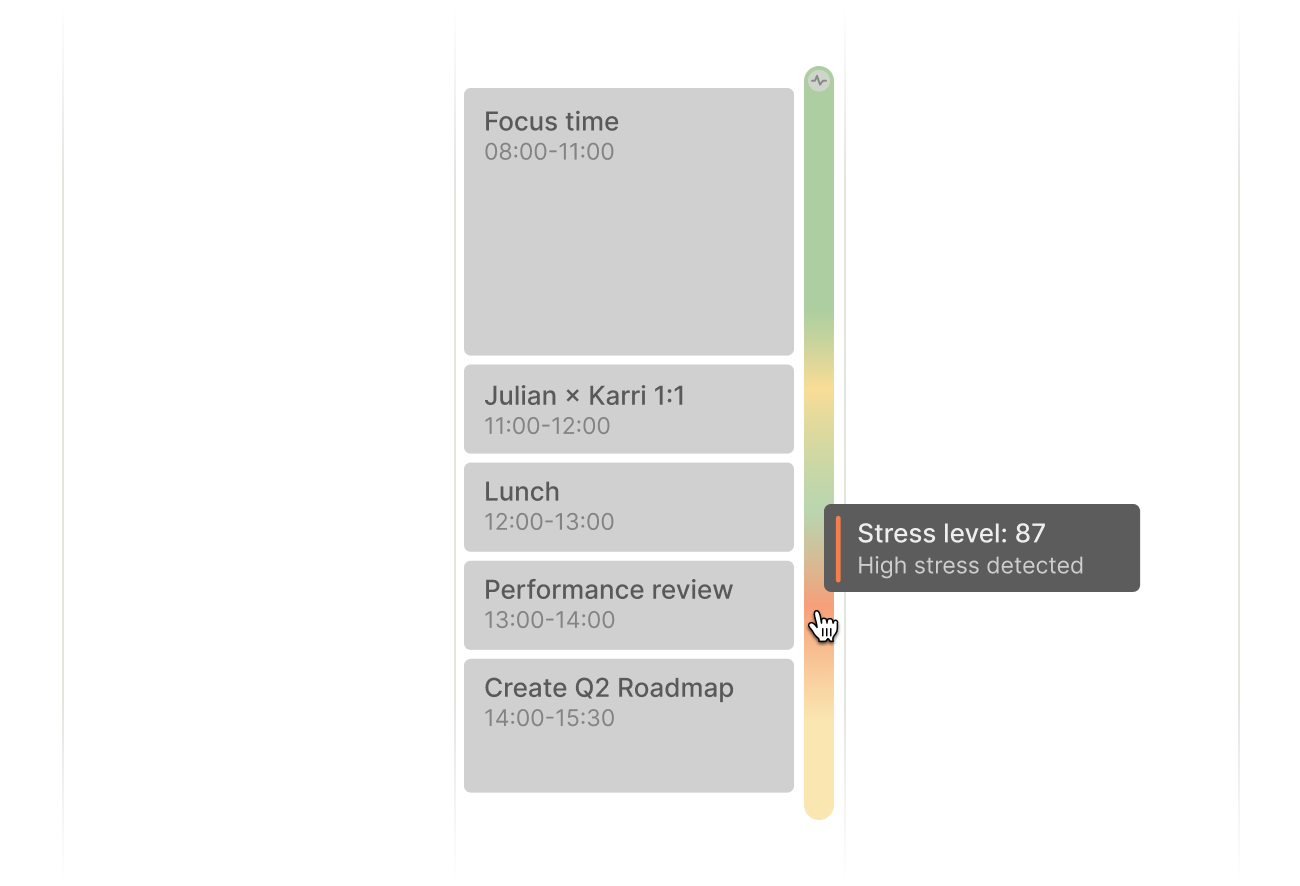
Our digital calendars turned out to be just marginally better than their pen and paper predecessors. And since their release, neither Outlook nor Google Calendar have really changed in any meaningful way.Source: Multi-layered calendars | julian.digital[…]
Flights, for example, should be native calendar objects with their own unique attributes to highlight key moments such as boarding times or possible delays.
This gets us to an interesting question: If our calendars were able to support other types of calendar activities, what else could we map onto them?
[…]
Something I never really noticed before is that we only use our calendars to look forward in time, never to reflect on things that happened in the past. That feels like a missed opportunity.
[…]
My biggest gripe with almost all quantified self tools is that they are input-only devices. They are able to collect data, but unable to return any meaningful output. My Garmin watch can tell my current level of stress based on my heart-rate variability, but not what has caused that stress or how I can prevent it in the future. It lacks context.
Once I view the data alongside other events, however, things start to make more sense. Adding workouts or meditation sessions, for example, would give me even more context to understand (and manage) stress.
[…]
Once you start to see the calendar as a time machine that covers more than just future plans, you’ll realize that almost any activity could live in your calendar. As long as it has a time dimension, it can be visualized as a native calendar layer.
Your personal time management strategy sucks
Too many pointless TLAs (Three Letter Acronyms) in this blog post, but it’s redeemed by having a core message that human beings are not cogs in a machine and have a finite time to accomplish their goals.
Although there have been plenty of people I’ve come across in my career who are always “super busy” there’s one person in my orbit in particular at the moment who seems to carry the world on their shoulders. As this post points out, this is due to an inability to focus on what’s important.
(The diagram below exudes peak 1990s management consultancy vibes, so I’m only including it for comedy value.)
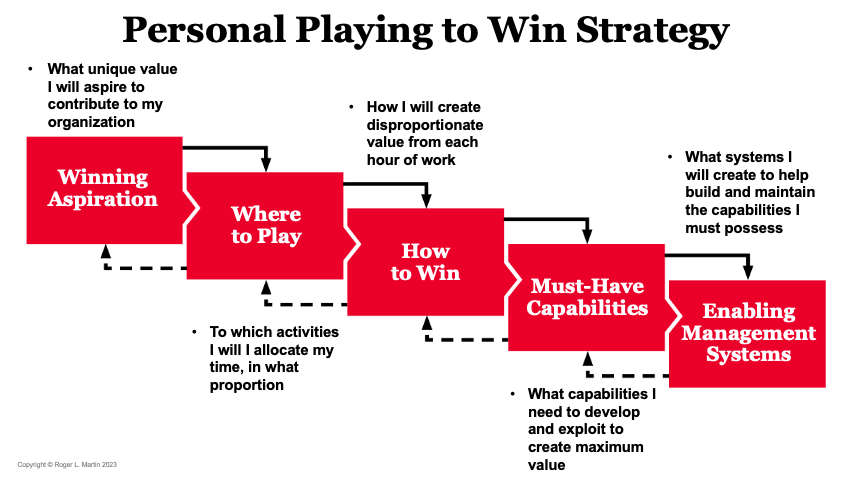
People inform me they are busy as if it is a badge of honor. For me, it is a signal that they have a weak personal Playing to Win strategy.Source: Being ‘Too Busy’ Means Your Personal Strategy Sucks | Roger Martin[…]
[T]o have an effective personal strategy, you need to be deliberative about choosing where to deploy your limited available hours in tasks that your particular set of capabilities enable you to generate a win by creating disproportionate value for your organization. And, since this doesn’t happen automatically, you need a personal management system for doing it on an ongoing basis — because on this front, eternal vigilance is the price of effectiveness.
[…]
Remember that strategy is what you do not what you say. So, even if you don’t think of yourself as having a personal Playing to Win strategy, step back and reverse engineer what it actually is based on what you actually do.
Giving advice online without mansplaining
In the last few days I rediscovered this post from Another Angry Woman via someone linking to it. I don’t think I shared it at the time, but it helped me understand how even well-meaning advice can be spectacularly unhelpful.
I’d recommend reading the whole thing, especially if you identify as male. However, the main takeaway for me was to ask if the person wants advice. Most recently, for example, I enquired if someone was “just venting or would like advice based on my experience”. They replied they were just venting.

Remember Clippy from Microsoft Office? You’re just trying to write a letter, and this insufferable little paperclip is popping up constantly with his vapid googly eyes and awful eyebrows and that fucking condescending smirk and his horrid little bendy body and oh god the colour of that speech bubble, like slightly worrying vaginal discharge, and the “it looks like” why is it so passive aggressive why- Sorry, I lost myself there. In short, Clippy was an irritation, and you’re giving someone’s notifications tab the vibes of using Word in 1997, which nobody wants to go back to.Source: How to give advice on the internet without being an utter menace | Another angry woman[…]
There is a gendered element to this, too. Mansplaining is something which most women on the internet have experienced fairly frequently. It is exhausting. It is patronising. It is the background hum of patriarchy.
You might not personally be mansplaining. Maybe you’re not even a man. But those who have been on the receiving end of mansplaining are sensitive to it. Your attempt to help can come across as mansplaining, and throw you straight into the draining and exhausting pile.
[…]
When someone is not asking a question, they probably do not want advice. This means, you have not been invited to give it. Your advice is not welcome. No matter how much you think there’s a solution to their predicament or they could do things a little differently, you’ve not been invited to share your advice. So don’t.
Saying "I don't know" is a privilege
Paul Graham is a smart guy. He’s a venture capitalist, and here he’s in conversation with Tyler Cowen, an economist. Both men are further to the right, politically, than me — so I winced a little at their references to the ‘far left’.
That being said, it’s an interesting episode and Cowen’s rapid-fire questioning is a useful tactic for getting guests to be more candid than they would otherwise be. What I found fascinating about Graham’s responses was that he would often say “I don’t know” instead of the prosaic “that’s a great question”. I guess once you’ve got the standing he has, there’s no need for him to pretend otherwise.

Source: Paul Graham on Ambition, Art, and Evaluating Talent (Ep. 186) | Conversations with TylerTyler and Y Combinator co-founder Paul Graham sat down at his home in the English countryside to discuss what areas of talent judgment his co-founder and wife Jessica Livingston is better at, whether young founders have gotten rarer, whether he still takes a dim view of solo founders, how to 2x ambition in the developed world, on the minute past which a Y Combinator interviewer is unlikely to change their mind, what YC learned after rejecting companies, how he got over his fear of flying, Florentine history, why almost all good artists are underrated, what’s gone wrong in art, why new homes and neighborhoods are ugly, why he wants to visit the Dark Ages, why he’s optimistic about Britain and San Fransisco, the challenges of regulating AI, whether we’re underinvesting in high-cost interruption activities, walking, soundproofing, fame, and more.
Actions speak louder than words
This article popped up on my feeds a couple of weeks ago and I recognised the organisation behind the website. Having listened to an excellent Art of Manliness podcast episode featuring Dr John Barry, I knew that ‘The Centre for Male Psychology’ is actually legit.
What this article discusses I’ve found true in my own life. I am by temperament introspective, which means for many years I thought the answer to any form of melancholy came in thinking. But, actually, I’ve found the answer to be in action in doing things such as climbing mountains, running, and doing things with my hands.

The two ways of regulating emotions have implications for the field of mental health, which relies predominately on talking therapy – in particular talking about feelings. Does this not suggest that there could be, and perhaps needs to be, more emphasis on discussing the therapeutic value of action? It may not be practical to conduct therapy while engaged in physical activity such as a gym workout or while out walking in the streets, but the therapeutic discussion can at least focus more on the “doing” aspects of a man’s life. For example a therapist might ask how did problem XYZ make a man act out, along with exploring which physical activities or responses might help him to modulate such emotions more optimally in future. Does riding a Jet Ski, or going for a jog, or building some wooden furniture make him feel better or worse? Does that difficult manoeuvre in the video game remind of difficulties in his relationship with his girlfriend? Does the same video game provide some optimism that if he can get past the difficult manoeuvre within the game then perhaps he can find a way around the impasse with his girlfriend? Activities like these provide a symbolic canvas on which men project, and then work through various scenarios of real life, with potential to shift affective resonances in the process.Source: Men tend to regulate their emotions through actions rather than words | The Centre for Male PsychologyWhen a man talks about how he operated a lathe, did some welding, restored a bit of discarded and broken furniture, might he be sharing a strategy of how he successfully redirected suicidal feelings? Perhaps we should not be so quick to shut down these conversations with accusations of being work obsessed, effectively stymieing natural male expressions with injunctions to talk less about activities and to communicate more effusively with feelings words. For many men, activities are the preferred canvases on which they can process feelings and carve out some genuine psychological equilibrium.
This is probably a reason why men talk so much about work, sports, building things, computer games, recreational activities – it may be their preferred way of communicating the ways they wrestle with psychological issues. Sadly, the therapeutic industry is quick to chastise men’s preference for intelligent actions, conflating them with pathological reflexes such as unconscious acts of aggression, dependence on drugs and booze, and other destructive versions of so-called “acting-out” as they are so often branded.
Marginally Employed
For various reasons I will explain elsewhere this post by Dan Sinker, which I read this morning, was particularly important to my life. Dan is awesome, and am thankful for his candor.
A month or so ago I was at a cookout for an old work colleague and friend. It was 100% people who I haven't seen since at least the pandemic hit, and most of them a few years even before that. And so, obviously, the first question anyone would ask is "what are you up to now," and, well, that's sort of a hard question for me to answer. As has been established on this blog before, I do a lot of things. Some of them are job-shaped, while others look, well, like an entire fictional town in Ohio. All of them are important to me and all of them are a little hard to explain.Source: Best Laid Plans | dansinker.comAnd so it was on that night that my brain—sometimes a friend, other times an enemy—responded “Well, I’m marginally employed,” before launching into a full-throated explanation of the wild world of Question Mark, Ohio to increasingly concerned onlookers.
I left the cookout feeling pretty weird, if I’m being honest. Since I’d last seen most of the folks that were there, they’d moved on to really incredible work. And here I was cobbling together bits and pieces of job-shaped things while spinning a yarn about a town plagued with disappearances. And then there was the term I used: marginally employed, which felt right but also felt a little embarrassing.
And then something happened. I talked about this on Says Who afterward and I heard from a bunch of folks who said, basically: Hey, me too. And I realized like, wait a second: I want to be doing work like I’m doing. Work that’s weird and exciting and, admittedly, hard to describe to people while also gnawing on some ribs. I don’t want to be doing a 9-5. I want to be marginally employed.
And so I made a patch. It’s really simple, just maroon on white and set in Cooper Black, my very favorite typeface. It reads, simply, “Marginally Employed.” No apologies, no frills. I love it. You might too. It’s $10 and ships free in the US.
Almhouses as a way forward for social housing
While I’m aware of medieval almshouses, I didn’t know they were still a thing. It’s great that there’s more being built now than in Victorian times, and I hope this kind of approach, along with co-operative housing, becomes even more of a thing.
It looks like they could be particularly useful for helping everything from ending rough sleeping, to stopping premature deaths in old age from poverty.

Almshouses are the oldest form of social housing in the world: the oldest foundation still in existence dates from about 990. Legally, historically and socially unique – exempt from right to buy legislation and so remaining as a permanent part of the community once gifted – there are 30,000 throughout the UK, providing affordable housing for more than 36,000 residents.
They are owned and managed by a network of more than 1,600 independent charities, and nearly all market towns in the UK have at least one almshouse. In some rural areas, they are the only provider of affordable, community housing.
In a time of a severe shortage of affordable rental accommodation, almshouse charities have long been trying to get attention from philanthropists and the government to make the case that their role is more vital than ever – that they should be put at the forefront of the community housing concept, providing an “exemplar housing model”.
Now, a new research project, the Almshouse Longevity Study from Bayes business school, has given extra ammunition to their call finding that those fortunate enough to live in an almshouse receive a longevity boost of almost two and a half years – equating to an extra 15% of future life for someone aged in their early 70s.
Despite not looming large in the public’s awareness, more almshouses are being built today than have been since the Victorian era; while most are for elderly people, some have no age restrictions and are able to accommodate families, people with disabilities and key workers.
[...]Paul Mullis, the chief executive of the Durham Aged Mineworkers’ Homes Association, the biggest almshouse charity in the UK, agreed. “Our residents know they can look forward to tomorrow because the things that make people’s lives worth living haven’t changed in the 1,000 years that almshouses were created to target: community, safe and secure housing, a sense of purpose.”
